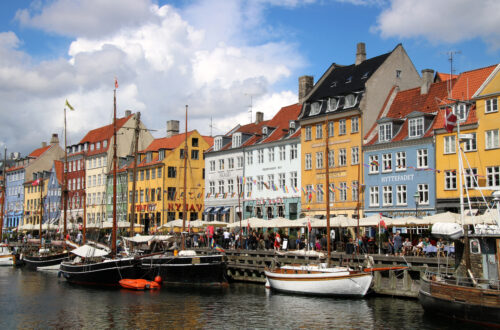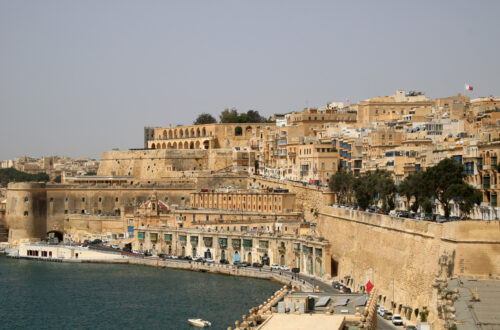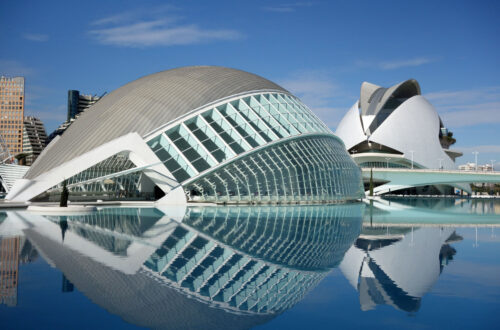Italy
Itinerary: Genoa – Pisa – Bracciano – Rome – Verona – Venice – Bologna – Milan
Genoa and Pisa
On a drowsy Sunday afternoon we leave for a two-week trip to Italy. We are traveling by train: The intercity to Brussels, the Thalys to Paris and the night train to Milan, a journey of nineteen hours. I don’t sleep a wink in the night train. As a result, I do experience the most beautiful part of the journey: Between four and six in the morning we drive through the Alps while the sun slowly rises. Arriving in Milan we decide to travel on to Genoa. At the end of the afternoon we are at a campsite in Rapallo, a village east of Genoa.
We spend our first day on the beach at Rapallo, located on a beautiful bay on the Thyrene Sea. On the pebble beach (there are no sandy beaches here) we are pretty much the only non-Italians. We catch up on some missed sleep. On the way back we want to walk a different route than the way there. For that we have to cross a big hill that separates us from the campsite. After a very long walk we have seen the entire hill, but we are not over it. In the end we take the same route back.
The next day we visit Genoa, the historic city on the west coast of Italy. In the fourteenth century, Genoa was a thriving port city. Now that the port is less lucrative, Genoa mainly attracts tourists to the medieval center and its maze of alleys. At the station you will immediately come across the statue of Christopher Columbus, who hailed from Genoa. From the port of Genoa you can see the old city against the hill. Side by side with contemporary design, such as the artworks on the boulevard. Many historic buildings are in a bad state. Right next to it are often ugly new buildings. What has been preserved is, among other things, the house of Columbus at the easternmost city gate.
On our way to Rome we made a stopover in Pisa. Not a very interesting city, but they do have that one tower that Pisa is known for: the leaning tower. Construction started in 1173, but already at the third floor the tower (campanile) began to tilt. It was not until 1350 that the bell tower was completed. To this day, the tower tilts an extra millimeter every year. Next to the leaning tower on the Campo dei Miracoli are the Baptistery and the Duomo. In the evening we arrive in Bracciano, a small town 40 kilometers north of Rome. From here we will visit Rome.
Rome and Bracciano
Legend has it that the daughter of a king, Rea Silva, had two sons from Mars. After their childhood was nursed by a she-wolf, they were adopted by a shepherd, whom they named Romulus and Remus. They are said to have founded the city on Palatine Hill, which is now called Rome. Romulus became the city’s first monarch after killing his brother during a leadership conflict.
During our walk in the city we pass the Ponte Fabricio from 62 BCE, the only classical bridge in Rome that still exists, without the help of restorers. We also pass Bernini’s Elephant fountain, which symbolizes the idea that intelligence should be the basis of wisdom. Then we walk over to the Panthéon. The Romanesque ruler Adrianus had the Panthéon built around 125 CE, a fine example of architecture to this day. From 609 CE, the Panthéon has been a temple. The only light enters through a hole in the roof, with a diameter of nine meters. It was not until the 20th century that such a large dome construction – without visible trusses – was built again.
There are two striking buildings on Piazza Venetia. The white-marble Vittorio Emanuele monument or ‘Altar of the nation’. Built at the turn of the last century to commemorate the unification of Italy. And the Palazzo di Venezia, a Renaissance palace that became best known because Mussolini moved in and turned the palace into the center of the fascist government.
Little is left of it, but the Forum was once the heart of the Roman Empire, the center of politics and religion and social meeting place in an already large city for that time. The columns are the remains of various temples that were dedicated to the gods and rulers. Better preserved is the Arch of Septimus Serverus in honor of his ten-year reign. Behind the Arch is the Curia (80 BCE) where the Senate met in the time of Julius Caesar. New laws were hung on a wall outside so that no one could say that the law was unknown to him. New excavations are still being carried out around the Forum today.
After the Forum we walk past the Palazzo Senatorio, now the City Hall of Rome. In front of the Palazzo are the Romanesque statues of Castor and Pollux that mark the Piazza Campidoglio designed by Michelangelo. In the Colosseum you imagine yourself in another time. The amphitheater dates from 72 CE. The Romans gathered here to watch the most brutal matches. Gladiator fights to prepare soldiers for the real battle, battles between humans and animals and animals among themselves. The gladiators made good money, many animals were killed, as well as many losers. In the 5th century the ‘games’ were banned. The floor of the arena has disappeared, exposing the maze below from which the animals were ushered into the arena. I think the Colosseum is one of the most impressive places we have visited in Italy.
After the Colosseum we visit the Vatican City, or Città del Vaticano, and the Piazza San Pietro with the Basilica San Pietro. Vatican City has been independent since 1929. Finally, we go to the Trevi Fountain, a construction by Bernini, who has many works in Rome to his name, and the Spanish Steps, which in fact have nothing Spanish about them. I think Rome is a beautiful city, where the ancient monuments and remains of cultural heritage have been preserved in the midst of a busy 20th century city.
After visiting Rome we have a relaxing day in Bracciano. Our tent is 1.5 meters from Lago di Bracciano. From the tent we have a breathtaking view over the lake.
Verona
On Monday we leave Bracciano in the direction of Padova. It’s a long ride, dring which we have to change trains, and late afternoon from the train we see the sky clouding over. We get out just before Padova, there is a campsite in Montegrotto. We walk through the rain to the campsite, which we cannot find. When we knock on the door of a chic restaurant to ask for directions, the owner’s daughter offers to take us to the campsite by car. The campsite turns out to be very expensive, but it’s already around 10 p.m. and it’s raining, so there is no other option than to stay here for the night and continue the next day.
The next day we continue on to Verona. From here we will make several trips. In Verona we find a beautiful campsite, located on a hill within the walls of an old castle. Every camping pitch has its own spot here, surrounded by trees and grapevines. Standing in front of the washbasin, you have a fantastic view over Verona.
Verona is a Romanesque city that stands out for its very friendly atmosphere. A city where we quickly feel at home. Most of the buildings date from the period when Verona was ruled by the Scaligeri family, in the 12th century CE. At the time Verona, like many Italian cities, was a city-state. The Arena is Verona’s impressive Romanesque monument. The Arena dates back to the first century CE and survived an earthquake in the 12th century. Even today, grand opera performances are held in the Arena. During our stay this was the Aida, where gladiators once fought to the death.
According to the story, Romeo Montecchi fell in love with Guilietta Capuleti. However, the family feud between the Montecchis and the Capuletis got in the way of their love. When her brother tells her that he killed Romeo, Guilietta takes his own life. Devastated by grief, Romeo rushes to Guilietta’s tomb. He does not want to live without his beloved and kills himself. Guilietta, however, was not dead. Now that her Romeo is dead, life has no meaning for her either and she also kills herself. This tragic story by Shakespeare was set in Verona, although the characters Romeo and Juliet are purely fictional. Juliet’s balcony, in the center of Verona, is a popular tourist attraction.
Venice
Venice has a long history. The Confederation of Islands was an ally of Byzantium in the sixth century, which effectively held sway over Venice. In 726, as the Byzantine Empire was weakening, Venice elected its first provincial government, headed by a ‘doge’. San Marco became the new patron of the city. Venice subsequently grew into an economic and political power. In 1797 Napoleon invaded Venice. Venice belonged to the Habsburgs until 1805, until Napoleon rejoined the area to his Italian kingdom. After Waterloo, Venice became Austrian again, until it became part of the kingdom again in 1866 with the unification of Italy.
The 80,000 inhabitants of Venice now receive about 20 million visitors each year. Venice is not a city of monuments (although there are many churches and palaces). In Venice it’s the maze of alleys and and the life on the water along the Molo and the Grand Canal that give the city its character. On the Piazatta, between the San Marco square and the Molo (the boulevard) are two columns. On one is San Theodoro, patron of Venice in Byzantine times, on the other a chimera representing St. Mark’s lion. In the past, executions took place between the columns. Superstitious Venetians deliberately do not walk between the columns. So neither do we.
Bologna and Milan
In one way or another Bologna is a bit disappointing. The city can rely on the fact that it has one of the best preserved historic centers, but for some reason it doesn’t really appeal to us.
Aftr a relaxed day at the campsite we visit the last city on our schedule: Milan. Milan is the city where time is money. Work ethic and consumerism are central to the lives of the Milanese dressed in the latest fashion. It’s the city of expensive shops and exclusive galleries. Appearance counts in Milan. The city does not have the historical character of, for example, Rome, but one monument cannot be avoided: the duomo. The cathedral, whose construction began in 1386 and lasted nearly five centuries, is the largest cathedral in the world. In real life it’s an impressive building. Of course we also walk down the Galleria Vittorio Emanuele, the cross-shaped shopping gallery that dates back to 1865, and we visit the Castello Sforzesco.
At the end of the day it’s time to go back to home. It was a wonderful trip!


